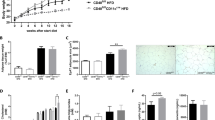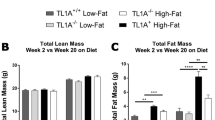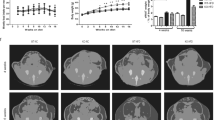Abstract
Background/objectives:
Lymphocytes have a critical role in visceral adipose tissue (AT) inflammation. The CD28 costimulatory molecule is required for lymphocyte activation and for the development of a functional regulatory T cells (Tregs) compartment; however, its role during obesity is unknown.
Methods:
During diet-induced obesity, we investigated the effects of selective interference with CD28 signaling using knockout mice (Cd28KO) and a CTLA4-Ig fusion protein inhibiting CD28-B7 interactions.
Results:
Cd28 deficiency decreased pathogenic T cells and Treg content within AT without changing the macrophages number. Cd28KO epididymal but not subcutaneous fat was characterized by enlarged adipocytes, reduced levels of inflammatory cytokines and increased Glut4, adiponectin and lipogenic enzyme mRNA levels. This was associated with reduced inflammation, fat accumulation and enhanced glucose metabolism in liver. Weight gain and fasting glucose tolerance were not affected. CTLA4-Ig injections reduced the number of T cells in epididymal AT (epiAT) but not the inflammatory cytokines levels and failed to improve liver fat accumulation.
Conclusions:
Deletion of CD28 creates a new pro/anti-inflammatory balance in epiAT and liver and exerts a protective effect against hepatic steatosis.
This is a preview of subscription content, access via your institution
Access options
Subscribe to this journal
Receive 12 print issues and online access
$259.00 per year
only $21.58 per issue
Buy this article
- Purchase on Springer Link
- Instant access to full article PDF
Prices may be subject to local taxes which are calculated during checkout





Similar content being viewed by others
References
Hotamisligil GS . Inflammation and metabolic disorders. Nature 2006; 444: 860–867.
Shoelson SE, Lee J, Goldfine AB . Inflammation and insulin resistance. J Clin Invest 2006; 116: 1793–1801.
Chawla A, Nguyen KD, Goh YP . Macrophage-mediated inflammation in metabolic disease. Nat Rev Immunol 2011; 11: 738–749.
Chatzigeorgiou A, Karalis KP, Bornstein SR, Chavakis T . Lymphocytes in obesity-related adipose tissue inflammation. Diabetologia 2012; 55: 2583–2592.
Nishimura S, Manabe I, Nagasaki M, Eto K, Yamashita H, Ohsugi M et al. CD8+ effector T cells contribute to macrophage recruitment and adipose tissue inflammation in obesity. Nat Med 2009; 15: 914–920.
Feuerer M, Herrero L, Cipolletta D, Naaz A, Wong J, Nayer A et al. Lean, but not obese, fat is enriched for a unique population of regulatory T cells that affect metabolic parameters. Nat Med 2009; 15: 930–939.
Winer S, Paltser G, Chan Y, Tsui H, Engleman E, Winer D et al. Obesity predisposes to Th17 bias. Eur J Immunol 2009; 39: 2629–2635.
Greenwald RJ, Freeman GJ, Sharpe AH . The B7 family revisited. Annu Rev Immunol 2005; 23: 515–548.
Shahinian A, Pfeffer K, Lee KP, Kundig TM, Kishihara K, Wakeham A et al. Differential T cell costimulatory requirements in CD28-deficient mice. Science 1993; 261: 609–612.
Green JM, Noel PJ, Sperling AI, Walunas TL, Gray GS, Bluestone JA et al. Absence of B7-dependent responses in CD28-deficient mice. Immunity 1994; 1: 501–508.
Tai X, Cowan M, Feigenbaum L, Singer A . CD28 costimulation of developing thymocytes induces Foxp3 expression and regulatory T cell differentiation independently of interleukin 2. Nat Immunol 2005; 6: 152–162.
Zhong J, Rao X, Braunstein Z, Taylor A, Narula V, Hazey J et al. T cell costimulation protects obesity-induced adipose inflammation and insulin resistance. Diabetes 2013; 63: 1289–1302.
Chatzigeorgiou A, Chung KJ, Garcia-Martin R, Alexaki VI, Klotzsche-von Ameln A, Phieler J et al. Dual role of B7 costimulation in obesity-related non-alcoholic steatohepatitis (NASH) and metabolic dysregulation. Hepatology 2014; 60: 1196–1210.
Honstettre A, Meghari S, Nunes JA, Lepidi H, Raoult D, Olive D et al. Role for the CD28 molecule in the control of Coxiella burnetii infection. Infect Immun 2006; 74: 1800–1808.
Amar J, Serino M, Lange C, Chabo C, Iacovoni J, Mondot S et al. Involvement of tissue bacteria in the onset of diabetes in humans: evidence for a concept. Diabetologia 2011; 54: 3055–3061.
Folch J, Lees M, Sloane Stanley GH . A simple method for the isolation and purification of total lipides from animal tissues. J Biol Chem 1957; 226: 497–509.
Poggi M, Engel D, Christ A, Beckers L, Wijnands E, Boon L et al. CD40L deficiency ameliorates adipose tissue inflammation and metabolic manifestations of obesity in mice. Arterioscler Thromb Vasc Biol 2011; 31: 2251–2260.
Mirenda V, Jarmin SJ, David R, Dyson J, Scott D, Gu Y et al. Physiologic and aberrant regulation of memory T-cell trafficking by the costimulatory molecule CD28. Blood 2007; 109: 2968–2977.
Kintscher U, Hartge M, Hess K, Foryst-Ludwig A, Clemenz M, Wabitsch M et al. T-lymphocyte infiltration in visceral adipose tissue. A primary event in adipose tissue inflammation and the development of obesity-mediated insulin resistance. Arterioscler Thromb Vasc Biol 2008; 28: 1304–1310.
Duffaut C, Galitzky J, Lafontan M, Bouloumie A . Unexpected trafficking of immune cells within the adipose tissue during the onset of obesity. Biochem Biophys Res Commun 2009; 384: 482–485.
Mantovani A, Biswas SK, Galdiero MR, Sica A, Locati M . Macrophage plasticity and polarization in tissue repair and remodelling. J Pathol 2012; 229: 176–185.
Mantovani A, Garlanda C, Locati M . Macrophage diversity and polarization in atherosclerosis: a question of balance. Arterioscler Thromb Vasc Biol 2009; 29: 1419–1423.
Winer S, Chan Y, Paltser G, Truong D, Tsui H, Bahrami J et al. Normalization of obesity-associated insulin resistance through immunotherapy. Nat Med 2009; 15: 921–929.
Burcelin R, Serino M, Chabo C, Garidou L, Pomie C, Courtney M et al. Metagenome and metabolism: the tissue microbiota hypothesis. Diabetes Obes Metab 2013; 15: 61–70.
Iynedjian PB . Molecular physiology of mammalian glucokinase. Cell Mol Life Sci 2009; 66: 27–42.
Ursini F, Mauro D, Naty S, Gagliardi D, Grembiale RD . Improvement in insulin resistance after short-term treatment with abatacept: case report and short review. Clin Rheumatol 2012; 31: 1401–1402.
Fujii M, Inoguchi T, Batchuluun B, Sugiyama N, Kobayashi K, Sonoda N et al. CTLA-4Ig immunotherapy of obesity-induced insulin resistance by manipulation of macrophage polarization in adipose tissues. Biochem Biophys Res Commun 2013; 438: 103–109.
Montes VN, Turner MS, Subramanian S, Ding Y, Hayden-Ledbetter M, Slater S et al. T Cell Activation Inhibitors Reduce CD8+ T Cell and Pro-Inflammatory Macrophage Accumulation in Adipose Tissue of Obese Mice. PLoS One 2013; 8: e67709.
Acknowledgements
We thank V Ferrier-Depraetere (Institut Paoli-Calmettes) for thoughtful reading of the manuscript. We are grateful to P Guichard and P Gibier for their help in animal handling feeding and body weight monitoring; F Gianardi (inter-IFR animal facility) for taking care of the Cd28KO mouse colony and finally C Fossat, I Arnoux and the CRCM cytometry platform for FACS analysis. This work was supported by the “Societé Francophone du Diabète”, the European society of cardiology (grant to MP) and by the “Comité du Var de la Ligue contre le cancer” (to JAN). JA Nunès and D Olive laboratory is supported by the Fondation pour la Recherche Médicale (Equipe FRM DEQ20140329534). SO Morin is supported by a fellowship from Aix-Marseille Université. D Olive is a scholar of the Institut Universitaire de France.
Author information
Authors and Affiliations
Corresponding author
Ethics declarations
Competing interests
The authors declare no conflict of interest.
Additional information
Supplementary Information accompanies this paper on International Journal of Obesity website
Rights and permissions
About this article
Cite this article
Poggi, M., Morin, S., Bastelica, D. et al. CD28 deletion improves obesity-induced liver steatosis but increases adiposity in mice. Int J Obes 39, 977–985 (2015). https://doi.org/10.1038/ijo.2015.26
Received:
Revised:
Accepted:
Published:
Issue Date:
DOI: https://doi.org/10.1038/ijo.2015.26
This article is cited by
-
Dynamic chromatin architecture of the porcine adipose tissues with weight gain and loss
Nature Communications (2023)
-
Investigation of candidate genes and mechanisms underlying obesity associated type 2 diabetes mellitus using bioinformatics analysis and screening of small drug molecules
BMC Endocrine Disorders (2021)
-
Qianggan extract improved nonalcoholic steatohepatitis by modulating lncRNA/circRNA immune ceRNA networks
BMC Complementary and Alternative Medicine (2019)
-
The role of immune cells in metabolism-related liver inflammation and development of non-alcoholic steatohepatitis (NASH)
Reviews in Endocrine and Metabolic Disorders (2016)



